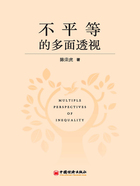
参考文献
[1]Acemoglu D,Restrepo P.The Race between Man and Machine:Implications of Technology for Growth,Factor Shares,and Employment[J].American Economic Review,2018,108(6):1488-1542.
[2]Atkinson A B.Inequality:What Can Be Done?[M].Cambridge,MA:Harvard University Press,2015.
[3]Autor D H.Why Are There Still So Many Jobs?The History and Future of Workplace Automation[J].Journal of Economic Perspectives,2015,29(3):3-30.
[4]Bourguignon F,Morrisson C.Inequality among World Citizens:1820-1992[J].American Economic Review,2002,92(4):727-744.
[5]Bratsberg B,Rogeberg O.Flynn Effect and Its Reversal Are Both Environmentally Caused[J].Proceedings of the National Academy of Sciences,2018,115(26):6674-6678.
[6]Chan Man-Kwun,Butt A P,Marriott A,et al.Public Good or Private Wealth?[R].Oxford:Oxfam,2019.
[7]Conard E.The Upside of Inequality:How Good Intentions Undermine the Middle Class[M].New York:Portfolio/Penguin,2016.
[8]Corak M.Income Inequality,Equality of Opportunity,and Intergenerational Mobility[J].The Journal of Economic Perspectives,2013,27(3):79-102.
[9]Crimmins E M,Zhang Y S.Aging Populations,Mortality,and Life Expectancy[J].Annual Review of Sociology,2019,45(1):69-89.
[10]Flynn J R.Massive IQ Gains in 14 Nations:What IQ Tests Really Measure[J].Psychological Bulletin,1987,101(2):171-191.
[11]Flynn J R.The Mean IQ of Americans:Massive Gains 1932 to 1978[J].Psychological Bulletin,1984,95(1):29-51.
[12]Frey C B,Osborne M A.The Future of Employment:How Susceptible Are Jobs to Computerisation?[J].Technological Forecasting and Social Change,2017(114):254-280.
[13]Gurr T R.The Roots of Terrorism[A]//Neumann P R.The Roots of Terrorism[M].New York&London:Routledge,2006.
[14]Hvistendahl M.While Emerging Economies Boom,Equality Goes Bust[J].Science,2014,344(6186):832-835.
[15]Kahneman D,Slovic P,Tversky A,et al.Judgment under Uncertainty:Heuristics and Biases[M].Cambridge:Cambridge University Press,1982.
[16]Krieger T,Meierrieks D.Does Income Inequality Lead to Terrorism?[R].SSRN Working Paper Series,2010.
[17]Krieger T,Meierrieks D.Income Inequality,Redistribution and Domestic Terrorism[J].World Development,2019(116):125-136.
[18]Lakner C,Milanovic B.Global Income Distribution:From the Fall of the Berlin Wall to the Great Recession[J].World Bank Economic Review,2016,30(2):203-232.
[19]Mankiw N G.Defending the One Percent[J].Journal of Economic Perspectives,2013,27(3):21-34.
[20]Milanovic B.Global Inequality:A New Approach for the Age of Globalization[M].Cambridge,MA:Harvard University Press,2016.
[21]Nelson R R,Sidney G W.An Evolutionary Theory of Economic Change[M].Cambridge,MA:Belknap Press of Harvard University Press,1982.
[22]Piketty T,Saez E.Income Inequality in the United States,1913-1998[J].The Quarterly Journal of Economics,2003,118(1):1-39.
[23]Piketty T,Saez E,Zucman G.Distributional National Accounts:Methods and Estimates for the United States[J].The Quarterly Journal of Economics,2018,133(2):553-609.
[24]Plomin R B.How DNA Makes Us Who We Are[M].London:Allen Lane/Penguin Random House,2018.
[25]Rawls J.Political Liberalism[M].New York:Columbia University Press,1993.
[26]Rawls J.A Theory of Justice[M].Cambridge,Massachusetts:Harvard University Press,1971.
[27]Sandel M J.What Money Can't Buy:The Moral Limits of Markets[M].New York:Farrar,Straus and Giroux,2012.
[28]Scheidel W.The Great Leveler:Violence and the History of Inequality from the Stone Age to the Twenty-First Century[M].Princeton,New Jersey:Princeton University Press,2017.
[29]Simon H A.Administrative Behavior,4th Edition[M].New York:Free Press,1997.
[30]Simon H A.A Behavioral Model of Rational Choice[J].The Quarterly Journal of Economics,1955,69(1):99-118.
[31]Simon H A.Theories of Decision-Making in Economics and Behavioral Science[J].The American Economic Review,1959,49(3):253-283.
[32]Thaler R.Toward a Positive Theory of Consumer Choice[J].Journal of Economic Behavior&Organization,1980,1(1):39-60.
[33]Thaler R H.Misbehaving:The Making of Behavioral Economics[M].New York:WW Norton,2015.
[34]Wilkinson R,Pickett K.The Inner Level:How More Equal Societies Reduce Stress,Restore Sanity and Improve Everyone's Well-Being[M].London:Allen Lane/Penguin Random House,2019.
[35]Wilkinson R,Pickett K.The Spirit Level.Why More Equal Societies Almost Always Do Better[M].London:Penguin,2009.
[36]国家统计局住户调查办公室.2017中国住户调查年鉴[M].北京:中国统计出版社,2018.
[37]罗伯特·诺奇克.无政府、国家和乌托邦[M].北京:中国社会科学出版社,2008.
[38]罗纳德·德沃金.至上的美德[M].南京:江苏人民出版社,2008.
[39]托马斯·皮凯蒂.21世纪资本论[M].北京:中信出版社,2014.
[40]谢宇,张晓波,李建新,等.中国民生发展报告2014[M].北京:北京大学出版社,2014.
[41]约瑟夫·E.斯蒂格利茨.不平等的代价[M].北京:机械工业出版社,2013.
[42]约瑟夫·费西金.瓶颈:新的机会平等理论[M].北京:社会科学文献出版社,2015.
[43]张涛.中国收入差距的变动及其原因分析:1985—2012年[J].数量经济技术经济研究,2016(12):3-22.
[1]根据国家统计局网站介绍,基尼系数可通过历年《中国住户调查统计年鉴》的第六部分“其他数据”和《中国统计年鉴》综合部分的“国民经济和社会发展比例和效益指标”查询。
[2]中信出版集团2019年的中译名为《不平等社会:从石器时代到21世纪,人类如何应对不平等》,leveler一词在该书正文中被译为“矫正”,即本书中提到的“推翻者”。
[3]他们在网站上提供了一个论文的初稿,但特别提到可能随时修改。该论文的题目为Income Inequality in the United States:Using Tax Data to Measure Long-term Trends。读者可随时用谷歌搜索查看其是否正式发表。本书所用的论文地址之一是:http://davidsplinter.com/AutenSplinter-Tax_Data_and_Inequality.pdf。